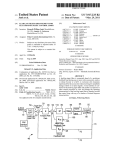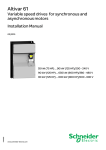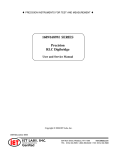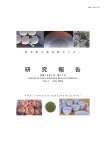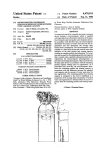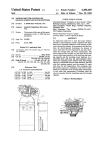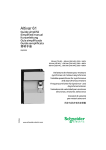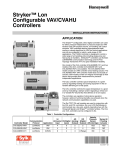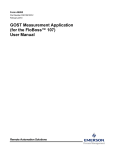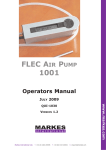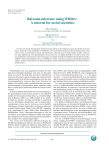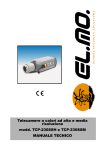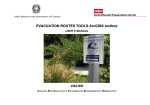Download Electronic gas meter
Transcript
O United States Patent [19] [11] Patent Number: Pearman et al. [45] [54] 4,637,253 1/1987 Sekimura et al. . 4,651,564 3/1987 Johnson et al. . ELECTRONIC GAS METER [75] Inventors: Arthur N. J. Pearman, St. Paul; Gerald D. Hunter, L1no Lakes; [73] Assignee: Date of Patent: Apr. 24, 1990 4,669,301 6/1987 Kratt et al _ 4,682,496 7/1987 Miura et al. . Michael A. Woessner, Golden Valley; Robert E. Gilman, s1. Michael, all Of MinnGas Research Institute, Chicago, 111. No.: 140,714 [22] Filed: 4,918,995 OTHER PUBLICATIONS ON SET Computer Corp., “TATTLETALE ® Model In”, Apphcatlon Note’ PP‘ 4’ 5 and 10*“ QUARTIC Systems, Inc., “TADC-l User’s Manual”, Manual 00174“, 1987. Jan‘ 4’ 1988 Primary Examiner—-Herbert Goldstein [51] [52] Int. Cl.5 .............................................. .. G01F 1/68 US. Cl. ............................ .. 73/861112; Attorney, Agent. or Firm—Th0mas W. Speckman [57] ABSTRACT _ [58] Field of Search ................... .. 73/204, 861, 861.02, An electronic compact gas meter includes a solid state 73/861.03, 861.77, 861.78, 204.11, 204.26 . [56] References cued U-S- PATENT DOCUMENTS 4,093,s71 4,308,753 pled to the sensor for controlling same and providing an output indicative of gas flow, and a digital data proces 6/1978 Plumb et al. ............... .. 73/861.03 X 4,306,457 12/1981 Fukui et al. . . . . ?ow sensor for sensing gas flow rate, data acquisition circuits including an analog-to-digital converter cou . . . . .. 73/861.77 SOY for receiving the gas ?OW information from the analog-to-digital converter, processing the information 1/1982 Olson ......................... .. 73/86L13 X and registering the volumetric gas flow reading at the 4,353,118 10/1982 Heimgartner et a1. ......... ._ 73/861 X meter and/or transmitting the Volume flow information Buchan """""""""""""" " 73/861 X via RF or telephone communication lines to a remote 4,481,827 11/1924 131151.411 et a1. ....................... .. 73/861 maim 4,534,2l8 v8/1985 Ueno 4,628,743 12/1986 21 Claims, 9 Drawing Sheets _____________________ __f"_\__ ____rlfj_\a__ i691", as I | L6—° \e2 A1 1/0 1| 1 BUFFER :1 I 1 ECU] 1 1 TOTALIZER E9 1 'HI g] r64 I1 A0 MUX f~ 1 '. AID 1 1 CONV 11 1l L63 1 i CPU t T 1I l | READOUT | COUPLER 1 '42 l ROM 1[ 66 REMOTE 1 1 :1 RAM @ l a _______________ ___lL___:____J US. Patent Apr. 24, 1990 7/ ////// --48 ---l5 Sheet 1 of9 4,918,995 //////// _2l ////7/'//////// FIG. 2 . FIG.2A US. Patent Apr. 24, 1990 . SAMPLE PERIOD T tsbia ‘Hie Sheet 2 on 4,918,995 9 US. Patent Apr. 24, 1990 Sheet 5 of9 4,918,995 ‘ 1L. 5 FIG8 5v ids?T US. Patent Apr. 24, 1990 <mGE mu-E3 Sheet 6 of9 4,918,995 US. Patent Apr. 24, 1990 4,918,995 Sheet 8 0f 9 (3171i) INITIALlZATlON J: SUBTRACT OLDEST ELEMENT OF SAMPLE BUFFER FROM SAMPLE ACC L POwER-UP MICROBRIDGE _ DRIVER CIRCUITRY LOW-POWER MODE FOR REMAINDER OF SAMPLE PERIOD A NO STABILIZATION TIME EXPIRED E, . YES FSAMPLE COUNTER = O SAMPLE COUNTER = K i SAMPLE TEMPERATURE SENSOR SAMPLE FLOW SENSOR CALCULATE TEMPERATURE COMPENSATION FACTOR POWER-DOWN MICROBRIDGE DRIVER CIRCUITRY ND NEGATIVE FLOW I? SET TAMPER FLAG ABSOLUTE vALUE - HG. | | OF FLOW US. Patent Aplr. 24, 1990 Sheet 9 of 9 INCREMENT SAMPLE COUNTER l J, UPDATE SAMPLE BUFFER ACCUMULATOR COMPUTE SAMPLE BUFFER ACCUMULATOR AVERAGE Jr FLOWCALC: TEMPERATURE COMPENSATED FLOW | FLOWACC= FLOWACC+ FLOWCALC | FLOWACC= FLOWACC~ IOOFT3 | INCREMENT INDEX 4, FIG. IIA | 4,918,995 1 4,918,995 2 The invention consists of certain novel features and structural details hereinafter fully described, illustrated ELECTRONIC GAS METER in the accompanying drawings, and particularly pointed out in the appended claims, it being understood that BACKGROUND OF THE INVENTION various changes in the details may be made‘without This invention relates to apparatus for measuring 5 departing from the spirit, or sacri?cing any of the ad usage of a commodity, and more particularly to an vantages of the present invention. electronic compact meter for measuring consumption of natural gas. Existing natural gas meters often do not meet modern expectations for allocating costs fairly to the end users. DESCRIPTION OF THE DRAWINGS For the purpose of facilitating and understanding the invention, there is illustrated in the accompanying For example, in multi-family dwellings, it is dif?cult to drawings a preferred embodiment thereof, from an in cost-effectively measure gas usage for each user to pro spection of which, when considered in connection with mote fair billing and encourage conservation of gas. It is the following description, the invention, its construc often dif?cult to access the meter in multi-family dwell 15 tion and operation, and many of its advantages will be ings for reading, inspection and maintenance. Theft and readily understood and appreciated. vandalism are also a signi?cant problem to the gas util ity industry. Moreover, installation costs and space are FIG. 1 is a perspective view of an electronic compact gas meter provided by the present invention; problems because of meter size and con?guration. FIG. 2 is a vertical section view of the compact gas It would be desirable to have an electronic compact 0 meter shown in FIG. 1; gas meter for either interior retro?t or for new installa FIG. .2A is a simpli?ed representation of the probe tions that is small in size and low in cost to as to enable assembly of the gas meter, showing the orientation of cost-effective measurement of usage of natural gas by a the solid state sensor relative to the duration of gas consumer. It would also be desirable to have a gas meter that would enable easy direct or remote reading, and 25 that is compatible with current construction materials flow; FIG. 3 is top plan view of the compact gas meter base with the printed circuit boards and battery removed; and utility operations. FIG. 4 is a plan view of a flow sensor of the compact gas meter provided by the present invention; FIG. 5 is a timing diagram illustrating the operating SUMMARY OF THE INVENTION Therefore, it is an object of the present invention to 30 cycle for the ?ow sensing circuitry; provide a new and improved natural gas meter. FIG. 6 is a block diagram of the electronic signal A further object of the invention is to provide a com processing circuits of the compact gas meter provided pact gas meter for either interior retro?t or for new installations that is small in size and low in cost so as to, by the present invention; FIG. 7 is a schematic diagram of the drive and signal enable cost-effective measurement of usage of natural 35 acquisition circuit of the electronic circuits of the com gas by a consumer. pact gas meter; Yet another object is to provide a gas meter that FIG. 8 is a schematic diagram of the analog-to-digital enables easy direct or remote reading. signal processing circuit of the electronic circuits; Another object of the invention is to provide an elec FIGS. 9 and 9a are a ‘schematic and partial block tronic compact natural gas meter which is easy to in 40 diagram of the digital signal processing circuit of the stall, reliable in operation and rugged and unobtrusive electronic circuits; in construction. FIG. 10 is a functional block diagram of the gas meter Yet another object of the invention is to provide a electronic circuits; and, compact natural gas meter characterized by low cost FIG. 11 and 11A are a flow chart illustrating the and maintenance. 45 process. These and other objects are achieved by the present Description of a Preferred Embodiment invention which is provided a compact electronic gas meter for measuring usage of natural gas or the like, Referring to FIGS. 1-3, the compact gas meter 10 which comprises a housing having a passageway there provided by the present invention includes a two-part through with a gas inlet adapted for connection to a case including a base 12 and a cover 13, a flow sensor source of natural gas and a gas outlet adapted for con probe assembly 14 including a solid state sensor 15, and nection to gas utilization means, gas flow sensing means mounted on the housing and including a solid state flow sensor and means of locating the flow sensor in the electronic signal processing circuits. The electronic passageway and operable when energized for providing 55 cover 13. The compact gas meter 10 further includes an an output signal indicative of gas flow through the indicating device embodied as a mechanical totalizer 19 ~ which provides a digital read out of the quantum of gas circuits being carried on a pair of printed circuit boards 17 and 18 mounted on the base and enclosed within the passageway; signal sampling means for periodically sampling the output signal provided by the ?ow sensor and generating a- signal representative of gas flow vol measured by the gas meter 10. As will be shown, the solid state sensor 15 provides a ume over a predetermined time interval, the signal sam 60 signal output indicative of the volume of gas flow through the gas meter. The electronic signal processing circuits 16 sample the signal output of the ?ow sensor 15 periodically and generate a signal indicative of the pling means de?ning operating cycles for said flow sensor each cycle including an active period of a ?rst duration'and an inactive period of a substantially longer ' duration, &he flow sensor being energized to provide its output signal only during the active period of its operat gas flow volume measured by the gas meter over a 65 given time period. This signal is applied to the totalizer ing cycle; and indicating means controlled by the sam pling means to provide an indication of the gas flow 19 which records a reading representative of the cumu lative gas flow volume measured by the gas meter. The volume measured by the gas flow sensor. flow sensor and electronic circuits of the gas meter are 3 4,918,995 battery-powered and include low-power consuming 4 serve the battery life. For example, the electronic cir cuits operate in an active mode during which the sam mounting screws 35 which are received in tapped holes 36 in the base near its upstream end 23. Referring to FIGS. 1-3, the cover 13 has a generally trapezoidal shaped cross section with a broad base 38, pling operation is done and a sleep mode during which the bottom edge of which is dimensioned to correspond elements which are operated in a manner so as to con the flow sensor is deenergized and the electronic cir generally to dimensions of the shoulder 26 on the upper cuits are maintained at minimum power usage. Also, the surface 31 of the base 12, to facilitate mounting of the cover 13 on the base 12. A suitable sealing means 39 use of a solid state ?ow sensing device and electronic signal processing circuits contribute to minimizing both the size of the gas meter and its cost and expanding its input/output capabilities, making the gas meter an at tractive substitute for conventional gas meters either in new installations or in retro?t applications to existing installations. Considering the meter 10 in more detail, the base 12 is 5 generally rectangular in shape and has a through bore 21 extending along the longitudinal axis of the base 12 de?ning a gas flow passageway through the gas meter 10. The gas meter 10 is adapted for connection to a source of natural gas supplied to the gas meter 10 by a suitable gas conduit or pipe represented by the dashed line 22 in FIG. 1. The inner surface of the bore 21 at the upstream end 23 of the gas meter is formed With‘an internal thread 24 to facilitate coupling of the gas meter (FIG. 2) is provided between the base and the cover to provide a water tight seal therebetween. As shown in FIGS. 1 and 2, the cover 13 encloses the upper surface 31 of the base 12 thereby containing the electronic circuits 16 therewithin. The cover 13 is se cured to the base 12 by a closing screw 41 passing through a lip 42 on the cover 13 into base 12. The screw 41 may be wired closed by an antitampering device 44 which is shown in FIG. 1, which threads through aper tures 45 in projections 46 on the lip 42 of cover 13. Referring to FIGS. 1 and 2, the cover 13 has a win dow 48 formed therein in the top surface of the gas meter through which is exposed to view a totalizer 19 which is mounted on the inner surface of cover 13. In one realization of the gas meter 10 which was constructed, the length of the base was approximately 10 to the pipe or gas conduit 22. Similarly, the down 25 6", the height of the meter from the bottom of the base stream end 23a of the gas meter is formed with an inter to the top of the cover was approximately 4.5” and the width of the base was approximately 2". The base was nal thread (not shown) to facilitate attachment thereto of an outlet gas conduit or gas pipe which conduits the made of a rigid material such as cast bronze and the gas to one or more utilization devices. As will be cover 13 was made of a rigid material such as plastic or shown, the gas meter can sense gas flow independent of aluminum. The physical size is slightly less than 67 cubic inches for this realization. However, the speci?c direction, and thus, while for convention the gas meter 10 is described as having a gas inlet and a gas outlet, the meter can measure gas ?ow in either direction between the inlet and outlet. This affords a degree of protection against attempts at compromising the meter by revers 35 ing its connection in the gas lines. In the exemplary‘ embodiment, the central bore 21 extends axially through the base 12, but it is apparent that the through bore could be offset laterally relative to the longitudinal dimensions recited are not intended to be a limitation on the scope of the invention, but rather to demonstrate the substantial reduction in size of the gas meter relative to gas meters presently in service. As indicated above, the gasket seal member 39 provides a water tight seal be tween the base 12 and the cover 13. Also, a suitable seal is provided between the gas inlet and outlet conduits 22, 22a (FIG. 1) and the base 12 of the gas meter, and the axis of the base 12. 40 ?ow sensor probe assembly 14 is designed to provide a Referring to FIGS. 2 and 3, the upper surface 31 of good gas seal under normal operating pressures. the base 12 de?nes a peripheral shoulder 26, a pair of Referring to FIGS. 2 and 3, the sensor probe assem longitudinal channels 27 and 28. As shown in FIG. 2, bly 14 includes a mounting portion 47, including retain channels 27 and 28 facilitate mounting of the printed ing collar 33, support portion 48, which extends into the circuit boards 17 and 18 which are mounted vertically 45 through bore 21 and locates the solid state sensor 15, within the gas meter 10 as shown in FIG. 2. The battery within the gas flow passageway de?ned by the through 29 energizes the electronic circuits of the gas meter 10. bore 21. The probe assembly has a connector portion 49 The battery used is one characterized by a long operat at its upper end which extends the conductors 32 from ing life, such as a lithium battery. the sensor 15 to the analog circuit board 18. The solid As shown best in FIG. 2, the base 12 has a vertically state sensor 15, to be described in more detail, is a gener extending bore 30 which communicates the upper sur ally rectangular shaped member as shown in FIG. 4 and face 31 of the base 12 with the through bore 21 and through which extends the ?ow sensor probe assembly extends generally coplanar with the direction of flow of the gas through the gas passageway de?ned by through 14. The channels 27 and 28 formed in the upper surface 31 of the base 12 are sized to receive the lower edges 17a and 18a of respective circuit boards 17 and 18, mounting the circuit boards 17 and 18 in a generally bore 21. As illustrated in FIG. 2A, the sensor 15 has an _ vertically extending position on the upper surface of the base 12. Circuit board 18 which carries the analog signal processing circuit 160 is electrically connected to the sensor probe assembly 14 by a set of conductors 32. Printed circuit board 17, which carries the digital signal processing circuit 161), is interconnected with the printed circuit board 18 by suitable connectors (not upstream end 15a and a downstream end 15b, and the sensor is located at approximately the mid-point of the passageway as illustrated in FIG. 2 by virtue of its mounting at the distal end of the probe assembly mount. The solid state sensor 15 is an immersion probe that directly senses gas flow through the gas conducting conduit. The principle of operation of the solid state sensor is similar to that of a miniature hot wire anemom eter, but differs in that the solid state sensor requires less heating power, is more sensitive to gas flow, is more 65 rugged, exhibits a faster response time, and can be fabri shown) and hard wiring. The flow sensor probe assembly 14 includes a mount cated using a batch fabrication process. ing collar 33 in the form of an annular ring having dia Referring to FIG. 4, which is a plan view of the solid metrically opposed apertures 34 through which extend state flow sensor of the flow sensor probe assembly 14, 5 4,918,995 the sensor consists of three sensors including an up stream flow sensor 51, a downstream flow sensor 52, a temperature sensor 53 and a heater element 54 all lo cated on the same substrate 55. The thin film resistive heater 54 is ?anked by the two resistive thin ?lm tem perature sensors 51 and 52. The upstream and down stream sensors 51 and 52 are connected to a differential ampli?er circuit and each is driven by a current from an individually associated constant current source. One ?ow sensor is located upstream of the heater and one is downstream of the heater. As a result of gas flow through the passageway of the gas meter, the sensors respond to different quantities of heat generated by the heater. The differential response is used as an indication of the rate of gas flow across the bridge sensor arrange ment de?ned by the two sensors 51 and 52 and the associated heater 54. Flow in either direction, i.e. from sensor 51 toward sensor 52 or from sensor 52 toward sensor 51, can be detected, the absolute value of the outputs will be the same in either case. In the absence of gas ?ow, the temperatures of the two sensors 51 and 52 are substantially the same. With gas flow over the semi conductor structure, the upstream sensor 51 is cooled and the downstream sensor 52 is heated. This results in an output signal which is detectable by the analog signal processing circuit 160 (shown in FIG. 6). As will be shown, the ?ow sensors 51 and 52 are sampled every T 6 chip or substitute 55 which temperature is not apprecia bly different from the ambient air temperature. The power required by heater resistor 54 to achieve 200 degrees centigrade above ambient temperature is very small being less than 0.010 watt. In the preferred embodiment at zero gas flow veloc ity, thermal conduction from heater resistor grid 54, largely through the surrounding air space heats the identical temperature sensing resistor grids 51 and 52 to an average temperature of about 140 degrees centigrade or about 70 percent of the temperature elevation of heater element 54. In the preferred embodiment illus trated, sensor grids 51 and 52 are precisely symmetri cally located with respect to heater grid 54 so that at zero gas ?ow they have identical temperatures and have no difference between their resistances. Consequently, a small probe current through both sensor resistances 51 and 52 will develop no voltage difference at zero gas flow velocity. With gas flow present, upstream resistor sensor 51 will be cooled by the transportation of heat away from sensor 51 toward heater resistor grid 54, whereas the downstream sensor 52 will be heated by transportation of heat toward the sensor 52 from heat resistor grid 54. 25 Consequently, a resistance difference between sensor resistances 51 and 52 will be present with a correspond ing difference in voltage drop which is a measure of the gas flow. Typical unampli?ed voltage differences can seconds and the temperature sensor 53 is sampled every be as high as 0.1 volt at a 1500 feet per minute ?ow kT seconds. The temperature sensor is used to compen sate the gas meter 10 for temperature variations. The 30 velocity. In the preferred operation of the solid state flow sampling period T is illustrated in FIG. 5 and will be described in detail hereinafter. Sampling of the state of the ?ow sensors 51 and 52 and the temperature sensor 53, as well as the energiza tion of the sensors and the heater 54 is provided by the Other arrangements are also possible including arrange electronic circuits 16 of the gas meter 10 which are ments which would operate the two temperature sen~ sensor, sensors 51 and 52 are driven with a constant current such that temperature ?eld changes can be sensed under flow conditions as previously described. sors in a constant voltage mode, a constant temperature shown in block diagram form in FIG. 6. Referring to FIG. 6, the electronic circuits 16 include (constant resistanpe) mode, a constant power mode, or any mode that produces a differential signal. an analog-to-digital signal processing circuit 160 and a digital signal processing circuit 16b, which are mounted 40 Referring now to FIG. 6, the temperature sensors 51 and 52 of the solid state flow sensor 15 are connected in on the two printed circuit boards (FIG. 2), 17 and 18, arms 70 and 70a of a bridge network, the sensors 51 and respectively. The structure and function of the analog to-digital signal processing circuit 16a and digital signal processing circuit 16b will be described hereinafter. 52 being energized by current supplied by respective constant current sources 71 and 72. The heater resistor Brie?y, the analog-to-digltal signal processing circuit 45 54 is energized by a further constant current source 74 16a includes a drive and signal acquisition circuit 61 (FIG. 7), a multiplexing circuit 62 (FIG. 8), and an and the reference temperature sensor 53 is driven by a constant current source 73a. The temperature sensor’s analog-to-digital converter 63 (FIG. 8). The digital signal processing circuit 16b (FIG. 9) includes a micro other bridge leg is driven by constant current source 73b. The ?ve constant current sources 71, 72, 73a, 73b and 74 are not continuously energized but are only processor system which includes a central processing unit CPU 64, an input/output buffer 65, memory cir cuits 66, and a real time clock 67. Considering the ?ow sensor 15 (FIG. 6) in more detail, the ?ow sensor corresponds to the solid state sensor described in U.S. Pat. No. 4,651,564, and the energized during a sampling interval de?ned by the central processing unit 64 as will be shown. The junction temperature sensors 51 and 52 are con construction, con?guration and operation of the solid nected to the inverting and non-inverting inputs, re spectively of a differential ampli?er 75, the output of which is extended to the multiplexer 62. Reference state sensor is described in detail in the US. Pat. No. temperature sensor 53 of sensor 15 and the temperature sensor’s other bridge leg, which includes resistor 53a, are connected to the inverting and non-inverting inputs Brie?y, with reference to FIG. 4, the How sensor 15 60 respectively of differential ampli?er 76, the output of which is extended to multiplexer 62. The multiplexer comprises a pair of identical thin ?lm heat sensors 51 4,651,564, and accordingly will not be described in detail herein. circuit 62 operates under the control of the central processing unit 64 to selectively extend to the analog to-digital converter circuit 63 the outputs of the differ the base. Sensors 51 and 52 are disposed on opposite 65 ential amplifiers 75 and 76, representing the flow rate of sides of heater 56. The heater resistor grid 54 operates at a preferred _the gas measured by the meter 10 and the reference constant average temperature difference of 200 degrees temperature provided by temperature sensor 53. As centigrade elevated above the temperature of silicon indicated, the reference temperature reading is sampled and 52, a thin ?lm heater 54 and a base or substrate 55 supporting the sensors and heater out of contact with 7 4,918,995 8 Referring to FIG. 8, the analog-to-digital converter less frequently than the flow rate signal provided by the differential ampli?er 75. 63 includes a programmable A/D converter circuit 91, a two-bit counter 92 de?ned by data latches 93 and 94 The analog-to-digital converter circuit 63 receives the output extended thereto from the multiplexer circuit and associated output logic gates 95-98, a power switch 62 and converts this output signal into a digital signal, which signal is applied to the central processing unit 64. The central processing unit 64 operates under program control to execute the operations necessary to effect the circuit 99 and an inverting voltage source 100 which converts +5 VDC to —5 VDC for the programmable analog converter 91. The multiplex circuit 62 is associ ated with the analog-to-digital converter circuit 63 and circuits 62 and 63 comprise an integrating converter analog processor such as the type commercially avail able from Quartic Systems, Inc. as the Model TADC-l periodic readout of the information provided by the flow sensor, to enable the analog circuits to receive this information, to read this information from the output of the analog-to-digital converter 63 and to calculate the A/D converter. The analog-to-digital converter features variable length conversions, adjustable from 9 bit resolution to 16 bit resolution by programming of the device by the user. The analog-to-digital circuit 63 is characterized by flow rate. The central processing unit 64 through input /output drivers 65 causes the current meter flow rate information to be registered on the totalizer 19 and supplies suitable commands to the analog circuits 16a to variable power consumption, typically 25 mw when on, 0 mw when off. The compact gas meter 10 operates at effect the sampling procedure. The central processing unit 64 also supplies information or data to a remote transmitting unit 20 enabling meter reading information and other information to be transmitted to a remote 16 bit resolution. The A/D input voltage is scaled so 20 that 2.5 VDC provides a full scale reading of 200 cubic feet per hour. Therefore, 16 bits provides 65,536 levels interrogation station, and to receive information and commands from such remote interrogation station to effect or alter the operation of the electronic circuits of of resolution or 0.003 CHF/level. This resolution is more than adequate at the lower flow rates where the the gas meter 10. 25 FIG. 7 is a schematic circuit diagram of the drive and signal acquisition circuits 61 that interface the solid state sensor 15 with the rest of the analog-to-digital signal processing circuit 160. Each of the ?ve constant current sources 71, 72, 73a, 73b and 74 are comprised of an output is nearly linear with flow. Because the multiplexer circuit 62 and the analog-to digital converter 63 comprise a commercially available unit as mentioned above, these circuits will not be de scribed in detail. Brie?y, the multiplexer circuit 62 com prises the type 4051 8 input multiplexer having two of its inputs labeled FLOW and TEMP connected to the operational ampli?er 81, 82, 83, 87 and 84, respectively, outputs of ampli?ers 75 and 76, respectively of the sig nal acquisition circuit (FIG. 7). The multiplexer circuit each having respective resistive networks which pro vide the desired current levels. A circuit 78 provides a stable 2.5 VDC reference voltage for the ?ve opera tional ampli?ers current sources that drive the tempera» ture bridge, the sensor bridge and the heater of the solid includes three input select inputs A, B, and C, which are selectable by signals applied thereto by over control output lines D1~D3 of the central processor unit (FIG. 9) as will be shown. The two-bit counter comprises a pair of data latches 93 and 94 connected in tandem with each connected for operation as a pulse divider to step the analog‘to-digital state sensor 15. Ampli?er 88 is a voltage follower that provides a high to low impedance transfer function between the 2.5 VDC reference and the ?ve constant current source inputs. converter through four conversion modes. The input Ampli?ers 83 and 87 are the constant current source stage data latch 93 has its clock input connected to a control output D12 of the central processing unit to drives for the onboard temperature sensor 53. Ampli?er 83 sources 100 microamps through the temperature sensor 53. Ampli?er 87 current sources 100 microamps receive a clocking pulse therefrom. The false output of latch 93 is connected to the clock input of data latch 94. through the ambient temperature bridge reference leg 45 The true outputs of the two data latches are combined resistance 53a. The temperature bridge current is set by resistors R17 and R21. The temperature bridge output is applied to an input of ampli?er 76, the output of which is connected via signal channel A1 to the multiplexer by NAND gate 95 which is connected to an invertor circuit 62 (FIG. 6). de?ned by NAND gate 96. The output of gate 96 is connected as one input to NAND gate 98, a second input of which is connected to an invertor 97. Invertor 50 The ?ow sensor de?nes three sensor elements includ ing upstream sensor 51, downstream sensor 52 and heater 54. These elements are driven by respective con stant current sources 71, 72 and 74 having associated operational ampli?ers 81, 82 and 84, respectively. The two ?ow sensors are operated with constant currents of 400 microamps each. The heater 54 is operated at a constant current the current level being set by resistor R6. Flow sensor current for sensor 51 is 'set by resistor R2. The sensor current for the downstream sensor 52 is 60 97 has its input connected to the output COMP of the programmable analog converter 91. Output COMP is also connected to a signal input D0 of the central pro cessing unit and the output of gate 98 is connected to a further input D13 of the central processing unit. Gates 94-98 provide the necessary logic to set input D13 appropriately for transmitting the result of the conver sion to the central processing unit input D0 signals the polarity of the sampled analog voltage to the central processing unit. The central processing unit also controls the opera tion of the analog-to-digital converter to the extent that resistor R25. an output on control line D6 effects reset (prior to each The output of the flow sensor bridge is ampli?ed by conversion sequence) of the two-bit counter 92. An ampli?er 75. The gain for ampli?er 75 is set by resistor output on control line D10 enables power switch circuit R1. The signal output of the ampli?er is ?ltered by a 65 99 to apply power at +V to the analog-to-cligital cir set by resistor R10 and bridge balance is provided by ?lter network comprised of resistor R30 and capacitor C10 and passed through a second signal channel A0 of cuits and to the flow sensor. the analog multiplexer. processing circuits provide the control signals for the Referring now to FIGS. 9 and 9A, the digital signal 4,918,995 10 analog~to-digital converter, as indicated, process data incoming from the ?ow of sensor 15, including calculat ing ?ow rates and updating the totalizer. The process ing unit may transmit information to a remotely located may comprise the microprocessor system commercially interrogate station (not shown) and receive information for example. Output _D4 of the central processing unit and commands therefrom via an interface network 100 increments the totalizer 19. Referring to FIG. 10,. which is a functional block diagram of the electronic circuits of the gas meter 10, the digital circuits 16b control the application of dc power to the sensor 15 and the analog-to-digital circuit 160, central processing unit of the digital circuits pro viding an output on line D10 for enabling power switch 99 which responsively extends Vdc to the sensor 15 and the analog circuits 16a. The central processing unit controls the analog circuits 160 over control lines D1~D3, D6 and D12 and receives outputs from the analog circuits 16a over lines D0 and D13. The signal outputs of the sensor 15 is extended to the analog cir available as the Model III Tattletale commercially available from Onset Computer Corporation. The totalizer 19 may be the HECON series GO634, using RF signaling or telephone line communication as is known in the art. The digital signal processing circuit includes the cen tral processing unit 64, memory circuits 66, the remote interface network 65, and a real time clock 67. The central processor includes 16 address inputs connected over an address bus 111 to the memory circuits 66, eight data outputs D0-D8 which are connected via a data bus as inputs to the memory 66, and fourteen control/input ports D0-D13 which supply information to and receive information from the analog-to-digital converter circuit 16a. As indicated, the central processing unit 64 provides cuits 160 over lines A0 and A1, which outputs are the the control signals for the analog-to-digital converter circuits. The control line functions are shown in Table I along with the default functions for these lines. TABLE I Line Default Use D0 Dl,D2,D3 D4 none none none POL ENA D6 D10 none none RST PWR input for polarity detection selects analog MUX channel drive signal for accumulator output for system reset output for power control D12 Dl3 TONE PERIOD CLK EDC output for clocking mode input for end-of-conversion Use ?ow and reference temperature, respectively. Control outputs D1-D3 control the multiplexer cir cuit 62 to provide selection for the signal on line A0 or line A1 for the analog circuits. Control output D6 resets the analog-to-digital converter 63. Control output D12 25 sequences the analog-to-digital converter. Input D10 enables the central processing unit to detect the polarity of the analog signal being processed and input signals D13 indicates end of conversion operation for the ana log-to-digital converter. The central processing unit operates under program control to ?rst call a power up routine to energize the analog circuits 16a and the sensor 15. The central pro cessing unit then calls a conversion routine and controls Referring to FIG. 9, the central ‘processing unit 64 provides the following major functions for the compact the analog-to-digital converter in taking a reading of the sensor ?ow value and reference temperature value and returns the results of the conversion to the central pro gas meter 10: 1. All control functions for the analog-to-digital con~ verter; cessing unit. The central processing unit then calls a power down routine to deenergize the analog circuits 16a and the sensor 15. Finally, the central processing _ 2. Control of power on-time to the analog-to-digital converter and sensor circuits including de?ning a sleep unit increments the totalizer 19 to re?ect the most re mode; cent gas flow reading. The procedure by which the sensor output is sampled 3. Reads the output on the analog-to-digital converter for flow rate and ambient temperature and computes the necessary correction factors required to correct for is dependent upon two parameters. The ?rst is the sam 45 ple period, T, which dictates the frequency of the sam flow, temperature or pressure if necessary; and pling. The second is the number of samples, k, which 4. Keeps track of accumulated flow and outputs to are integrated when computing the current volumetric the totalizer 19 or other media such as RF or telephone ?ow rate. modem for remote readout mode via the interface net Referring to FIG. 4, in the exemplary embodiment, work 100. the sampling period T is one second. Voltage V1 is a For the digital signal processing circuits shown in ?xed offset voltage set by resistor l226 (FIG. 7) at the input of ampli?er 76. The voltage V2 is the sensor volt FIGS. 9 and 9A, circuits 121 (U2) and 122 (U10) pro vide encoding for chip selection. Circuit 123 (U3) is a 32K by 8 bit Eprom memory for program storage. Cir cuit 124 (U4) provides 32K by 8 bit static RAM for program development and storage. Circuits 125 (US) and 126 (U6) provide 32K by 8 bit static RAM data storage. Circuits 127 (U7) and 128 (U12) interface the age response. This response varies as a function of the ?ow rate past the sensor. This signal is ampli?ed by ampli?er 75 prior to application to the analog-to-digital converter. The total conversion time is typically about 112 ms and includes a settling time is of about 60 ms, and integration time ti of about 24 ms for a l6-bit conver central processing unit 64 with a RS 232 mode to enable down or up loading of data or for interfacing the central processing unit 64 with another computer. Circuit 67 (U9) de?nes a real time clock circuit which provides real time data for use by the central processing unit in specifying the time of occurrence of gas flow, etc. sion, and a deintegration time td which varies propor 60 tionally to the analog-to-digital converter input voltage. The balance of the cycle time is the data processing period. A running average of a plurality of raw signal samples is used to compute the volumetric ?ow reading which is used to update the flow counter. A similar The central processing unit 64 is an 8 bit CMOS 65 A/D conversion is made on the output of the tempera ture sensor, but is done only once every 32 samples. More speci?cally, a running average of the most recent “k” samples of the differential responses is main microcomputer such as the type 63 AO3Y commercially available from Hitachi. Moreover, the entire digital signal processing circuits illustrated in FIGS. 9 and 9A, 11 4,918,995 12 tained by the meter. The “k” sample values are stored in the data memory, the set of sample values being up dated each sampling by substituting the current or circuits are shut down after each sampling sequence. Reading the temperature less frequently does not affect accuracy because the temperature will not slew as fast “newest” sample value for the “oldest” sample value. The average of this updated set of “k” samples is used as the current reading of gas flow. This average is used to compute, using a table look-up derived from meter as the flow data will. calibration data, the corresponding volumetric flow The running average is used in order to account for noise which could otherwise adversely affect the gas flow readings obtained. The central processing unit de?nes a “sliding window” which basically comprises a running average of the data taken over a given interval, or a number of data samplings, for example, thirty-two. With each sampling operation, the oldest value is de leted and the newest value is added and averaged with rate for the current sample period. Various methods for obtaining calibration data are known in the art. The flow rate sample is compensated for ambient tempera ture variations using a temperature compensation de rived from the last sample output obtained from the the previous 31 values. This running average of thirty reference temperature sensor 53. The compensated two readings may vary relative to the direction of value is multiplied by a time value T yielding the vol 15 change of the flow rate. Data obtained for each reading ume of gas usage for the current sample period. This is averaged into this running average and used as the volume measurement is then added to the meter’s flow current reading. A test is made prior to this averaging accumulation register in memory. This register is then and if the data does not compared favorably, then the compared with a flow resolution register established for latest obtained data is ignored. Thus, for example, if the the meter and the mechanical totalizer 19 is incre 20 reading from one sample to the next sample changes mented each time a given flow volume is measured. By from a certain value to zero, for example, it can be way of example, the ?ow resolution register value is set assumed that noise or some other error has created this at 100 cubic feet (cf), the mechanical totalizer 19 is change and the reading is ignored. This comparison stepped each time that the flow accumulation register reduces the effect of the bad reading and eliminates or count equals or exceeds this value. The reading stored 25 substantially reduces the susceptibility to noise. by the accumulation register is reduced by 100 of each Referring to FIGS. 11 and 11A, there is illustrated a time that the totalizer is incremented. process ?ow chart for the central processing unit. Upon In the exemplary embodiment, a ?xed sample period is used in the sampling of the sensor for the gas meter - startup, the program ?rst executes an initialization rou 10. It is possible to make the sampling period, T, a func 30 tine. After initialization, the ?rst step in the program is to adjust the running average of the “sliding window” tion of the ?ow rate and the acceleration of the ?ow by subtracting the oldest element of the sample buffer rate, i.e., rate of change, as measured by the meter. from the sample accumulator. Then the central process When a variable sampling rate is used, the sampling rate ing unit enables power circuit 99 (FIG. 8) to energize is set higher during high flow rates to decrease error and set lower during low flow rates, where the accu 35 the analog circuitry and the flow sensor, and after the stabilization time has expired, a test is made to deter racy speci?cation is more lenient, to decrease power mine if it is time to read the temperature sensor. If so, consumption. On a time scale of one year depending on the sample counter is set to zero, the temperature sensor the environment, the average flow rate is likely to fall into the lower flow rate range, and thus use of a variable sampling rate can be used to reduce power consump tion. Also, when the acceleration of the ?ow rate is low, i.e. not changing signi?cantly, sampling can be carried out on a lower frequency basis whereas when the accel output is sampled and the temperature compensation factor is calculated and stored as an updated tempera ture compensation factor. Then the program returns to the main ?ow. At this point, or if the test indicated that it was not time to sample the temperature sensor, the program continues and samples the flow sensor. After eration is high, a faster sampling rate is employed. With reference to FIGS. 6 and 10, the central pro 45 the sampling operation is completed, the analog-to-digi tal circuits and the flow sensor 15 are deenergized. cessing unit 64 operates under program control to read Then a test is made to determine if the direction of the the information provided by the flow sensor 15, via the flow is negative, indicative of tampering with the meter analog-to-digital converter, update the flow reading by reversing its connections to the gas pipe link. If the information stored by the central processing unit and to flow rate signal is negative, then the absolute value of periodically update the current gas flow volume read the flow rate signal is used n the flow rate calculation ing and update the state of the totalizer 19. The central and a tamper flag is set. processing unit de?nes a sleep mode and periodically Then the sample counter is incremented and the sam energizes the ?ow sensor 15 and the analog-to-digital ple buffer accumulator is updated. The sample accumu circuit 160 for a brief sampling interval, maintaining these circuits energized only during the sampling inter 55 lator average, including the current measurement sam val. ple and the precious 31 samples, is computed and the In the exemplary embodiment, the information is read once every second. First, the central processing unit enables power switch 99 (FIG. 8) to apply power to the flow sensor 15, and the analog-to-digital circuit 16a, including the analog multiplexing circuit 62 and the flow rate is calculated using the most recent tempera ture compensation flow factor. Then the current flow rate is added to the accumulated flow rate stored in the flow rate register and a test is made to determine if the flow rate register count is greater than or equal to a value corresponding to 100 cubic feet. If not, the pro analog-toédigital converter circuit 63. The central pro cessing unit then de?nes a stabilizing period ts to enable gram loops back to the beginning, remaining in low the ?ow sensor heater to stabilize. Then the processor power mode for the remainder of the sample period. If reads the gas flow rate sensor. As indicated, the temper 65 the flow accumulator value is equal to or greater than ature sensor 53 is read at a slower rate, or that is, less the resolution value, then the flow register value is frequently, than differential output of the flow sensors 51 and 52 to conserve time and thus power because the adjusted to subtract one unit (100 cf ) and the totalizer 19 is incremented by one. 13 4,918,995 The central processing unit continues under program control to transfer the ?ow sensor and the analog cir cuits to the power up mode, to sample the output signals provided by the ?ow (and temperature) sensors and 14 6. A gas ?ow meter according to claim 1, wherein said signal sampling means includes sensor, signal de tecting means for detecting said output signal, and sig nal processing means connected to said signal detecting means and responsive to said output signal for generat- _ store the information before deactivating the flow sen ing a gas flow volume output signal indicative of gas sor and the analog circuits. The reading is stored in flow volume over a given time interval and applying memory and thus stored information is used to incre said gas ?ow volume output signal to said indicating ment the mechanical totalizer as each 100 of unit of gas means. ?ow is measured. 7. A gas flow meter according to claim 6, wherein 10 We claim: said signal processing means averages the values of 1. A compact gas meter for measuring usage of natu ral gas or the like by a consumer over a time interval to enable of the consumer by a utility, comprising: a housing having a passageway therethrough with a gas inlet adapted for connection to a source of natural gas provided by the utility and a gas outlet adapted for connection to gas utilization means of the consumer, gas flow sensing means mounted on said housing and in cluding a solid state ?ow sensor having a substrate bearing a thin film heating element and ?rst and second thin ?lm temperature sensing elements ?anking said heating element, and means locating said flow sensor in said passageway to directly sense gas flow through said passageway, said ?ow sensor being oriented to extend generally coplanar with the direction of flow of the gas through said passageway, with one of said temperature sensing elements located upstream of the gas flow through said passageway and the other one of said tem perature sensing elements located downstream of the gas flow, said ?ow sensor being operable when ener gized to provide an output signal indicative of gas flow rate through said passageway, signal processing circuit means‘ mounted within said housing and electrically connected to said ?ow sensor, said signal processing circuit means including signal sampling means for peri odically sampling the output signal provided by said successive output signals of said ?ow sensor over a time interval in generating said gas flow volume output sig nal. 8. A gas flow meter according to claim 7, wherein said signal processing means includes signal accumulat ing means for accumulating signals corresponding to the gas flow volumes represented by a series of said output signals of said flow sensor and the average value of the gas flow volume represented by said accumulated output signals accumulated by said signal accumulating means, and wherein for each successive sampling per iod, said signal processing means adds to said accumu lated signals a signal corresponding to the value of the gas ?ow volume represented by the current output signal and subtracts from said accumulated signals a signal corresponding to the value of the gas ?ow vol ume of the ?rst of the series of the accumulated output signals. 9. A gas flow meter according to claim 6, wherein said ?ow sensor includes reference sensor means pro viding a reference output signal indicative of ambient temperature, said detecting means including means for detecting said reference signal, and said signal process 35 ing means responding to said reference signal to com pensate the flow rate output signal for changes in ambi ent temperature relative to a preselected value. 10. A gas meter according to claim 9, wherein said ?ow sensor during sampling periods and generating a signal representative of gas flow volume over a prede signal processing means samples said signal ‘output of termined time interval, power switch means responsive 40 said reference sensor means at a rate substantially less to said signal sampling means for energizing said flow than the sampling rate for said gas flow sensor. sensor during said sampling periods, said signal sam 11. A gas meter according to claim 6, wherein said pling means de?ning operating cycles for said power signal sampling means is adapted for energization by a switch means, each operating cycle including an active battery and wherein said power switch means connects period of a given duration and an inactive period of a 45 said flow sensor to the battery during said active peri substantially longer duration, said power switch means ods. energizing said flow sensor enabling said flow sensor to 12. A compact gas meter associated with a building for measuring usage of natural gas or the like, there of each operating cycle, and indicating means con within by a consumer, said gas meter comprising: iridi trolled by said sampling means to provide an indication 50 cating means for providing‘ an indication of gas flow of the gas flow volume measured by the gas flow sensor. volume over a time interval to enable billing of the 2. A gas meter according to claim 1, wherein said consumer by a utility, a housing having a passageway signal sampling means samples said output signal of said therethrough with a gas inlet adapted for connection to flow sensor at a ?xed sampling rate. a source of natural gas provided by the utility and a gas 3. A gas meter according to claim 2, wherein said outlet adapted for connection to gas utilization means of provide its output signal only during the active period signal sampling means samples said output signal a plu rality of times during the active period of each operat ing cycle. the consumer, gas flow sensing means mounted on said housing and including a solid state flow sensor and means locating said flow sensor in said passageway to 4. A gas flow meter according to claim 1, wherein directly sense gas ?ow through said passageway, said ?ow sensor being oriented to extend generally coplanar for sampling said output signal of said ?ow sensor as a with the direction of flow of gas through said passage function corresponding to the flow rate of gas through way, said flow sensor being operable when energized to said passageway for a given time duration. provide an output signal indicative of gas flow through 5. A gas flow meter according to claim 1, wherein said passageway, signal processing circuit means said signal sampling means de?nes the sampling period 65 mounted within said housing and electrically connected for sampling said output signal of said flow sensor as a to said flow sensor, said signal processing circuit means function corresponding to the rate of change of the flow including signal sampling means for periodically sam said signal sampling means de?nes the sampling period rate for a given time duration. pling the output signal provided by said flow sensor and 15 4,918,995 16 generating a signal representative of gas flow volume tially longer duration, said power switch means energiz over a predetermined time interval, power switch means responsive to said signal sampling means for ing said circuit means and said ?ow sensor only during energizing said flow sensor during said sampling period; said signal sampling means de?ning operating cycles for means controlled by said signal sampling means to pro vide an indication of the gas ?ow volume measured by said power switch means, each operating cycle includ the gas flow sensor. the active period of each operating cycle, and indicating ing an active period of a given duration and an inactive 17. A gas meter according to claim 16, wherein said period of a substantially longer duration, said power flow sensor comprises a reference temperature sensor switch means energizing said ?ow sensor enabling said for providing a reference output signal indicative of ambient temperature, said signal sampling means in cluding means for detecting said reference output signal and for compensating said output signal of said flow ?ow sensor to provide its output signal only during the active period of each operating cycle, said indicating means being controlled by said sampling means to pro vide an indication of the gas flow volume measured by sensor for variations in ambient temperature from a the gas ?ow sensor. given value. 13. A gas meter according to claim 12, wherein said 18. A gas meter according to claim 17, wherein said signal sampling means includes signal detecting means signal sampling means comprises signal multiplexing for detecting said output signal, and signal processing means, analog-to-digital converter means and processor means connected to said signal detecting means and means, said signal multiplexing means being controlled responsive to said output signal for generating a gas flow volume output signal indicative of gas flow vol by said processor means to selectively extend said flow signal and said reference signal to said analog-to-digital ume over a given time interval and applying said gas converter means, said analog-to-digital converter means flow volume signal to said indicating means. 14. A gas meter according to claim 13, wherein said signal processing means averages the values of output signals provided over a number of successive sampling intervals to provide an average output signal for use in being controlled by said processor means to convert analog signals extended thereto to digital signals, said processor means using said digital signals to compute 25 gas flow volume signals for application to said indicat ing means. 19, A gas meter according to claim 16, wherein said calculating the gas volume flow volume output signal for each sampling interval. housing comprises a base portion having said passage 15. A gas meter according to claim 14, wherein said way formed therethrough and a cover portion con signal processing means adjusts said average output natural gas or the like by a consumer over a time inter structed and arranged for mounting on said base portion de?ning a compartment, said signal processing circuit means being mounted within said compartment, and said gas ?ow sensing means including a probe assembly, said base portion having a passageway communicating said compartment with said passageway in said base val to enable billing of the consumer by a utility, com portion, said probe assembly being mounted in said prising: a housing having a passageway therethrough aperture with one end carrying said ?ow sensor located with a gas inlet adapted for connection to a source of in said passageway and another end extending adjacent to said signal sampling means facilitating connection of the signal output of said flow sensor to a signal input of said signal sampling means. 20. A compact gas meter for measuring usage of signal in accordance with calibration data for the gas meter prior to applying the averaged output signal to the indicating means. 16. A compact gas meter for measuring usage of natural gas provided by the ulility and a gas outlet adapted for connection to gas utilization means of the 40 consumer, gas flow sensing means mounted on said housing and including a solid state ?ow sensor and means locating said flow sensor in said passageway to natural gas or the like by a consumer over a time inter val to enable billing of the consumer by a utility, com directly sense gas flow through said passageway, said gas ?ow sensor including a ?rst thin ?lm temperature 45 prising: a housing having a base portion and a cover sensing element and a second thin ?lm temperature sensing element located downstream of said ?rst tem perature sensing element and a thin ?lm heater element located between said ?rst and second'temperature sens ing elements, said flow sensor being oriented to extend generally coplanar with the direction of flow of gas through said passageway, circuit means connecting said ?rst and second temperature sensing elements in a bal anced bridge con?guration to enable said flow sensor when energized to provide an output signal indicative of gas flow through said passageway signal processing circuit means mounted within said housing and electri cally connected to said flow sensor, said signal process ing circuit means including signal sampling means for periodically sampling the output signal provided by said portion, gas flow sensing means, signal sampling means, and indicating means, said base portion having a pas sageway therethrough with a gas inlet adapted for con nection to a source of natural gas provided by the utility and a gas outlet adapted for connection to gas utiliza tion means of the consumer, and said base portion hav ing an aperture communicating said passageway with an upper surface of said base portion, said gas ?ow sensing means including a solid state flow sensor having ?rst and second thin ?lm heat sensor elements and sup port means supporting said sensor elements, and mount ing means mounted on said base portion in said aperture thereof, locating said flow sensor in said passageway with one of said elements positioned upstream of the other element and with said sensor located approxi flow sensor and generating a signal representative of gas flow volume over a predetermined time interval, power switch means responsive to said signal sampling means for energizing said circuit means and said flow sensor mately at the mid-point of said passageway to directly of a given duration and an inactive period of a substan~ 7 means being operable to periodically sample the output sense gas ?ow through said passageway, said flow sen sor being operable when energized to provide an output signal indicative of gas flow in either direction through during said sampling periods, said signal sampling 65 said passageway, said signal sampling means being means de?ning operating cycles for said power switch mounted on said upper surface of said base portion and means, each operating cycle including an active period connected to said flow sensor, said signal sampling 17 4,918,995 . 18 , temperature sensing means, circuit means connecting signal provided by said flow sensor and generate a sig nal representative of gas ?ow volume over a predeter said ?rst and second temperature sensing means in a mined time interval, said signal sampling means de?ning operating cycles for said ?ow sensor, each operating balanced bridge con?guration to enable said flow sen sor when energized to provide an output signal indica tive of gas ?ow through said passageway, signal sam cycle including an active period of a given duration and an inactive period of a substantially longer duration, said flow sensor being energized to provide its output pling means for periodically sampling the output signal provided by said ?ow sensor and generating a signal representative of gas flow volume over a predetermined time interval, said signal sampling means including pro signal only during the active period of its operating cycle, said cover portion adapted for mounting on said base portion enclosing said ?ow sensing means, said cessor means and analog-to-digital converter means signal sampling means, and said indicating means there within, said cover portion having a window therein, and said indicating means being mounted adjacent to said window and exposed to view therethrough and being controlled by said sampling means to provide an indication of the gas flow volume measured by the gas flow sensor. 21. A compact gas meter for measuring usage of enabled by said processor means to convert analog signals provided by said flow sensor to digital signals for use by said processor means in calculating gas flow volume signals, said processor means obtaining the ab solute value of said analog signals for calculating said gas flow volume signals to thereby enable measurement of gas ?ow through said passageway in either direction, power switch means responsive to said signal sampling natural gas or the like by a consumer over a time inter means for energizing said circuit means and said flow val to enable billing of the consumer by a utility, com sensor during said sampling periods, said signal sam pling means de?ning operating cycles for said power prising: a housing having a passageway therethrough switch means, each operating cycle including an active period of a given duration and an inactive period of a with a gas inlet adapted for connection to a source of natural gas and a gas outlet adapted for connection to gas utilization means, gas flow sensing means mounted on said housing and including a solid state flow sensor and means locating said flow sensor in said passageway, substantially longer duration, said power switch means energizing said circuit means and said ?ow sensor only during the active period of each operating cycle; and indicating means controlled by said signal sampling said gas flow sensor including ?rst temperature sensing means to provide an indication of the gas ?ow volume measured by the gas ?ow sensor. means and second temperature sensing means located downstream of said ?rst temperature sensing means and =0! heater means located between said ?rst and second 35 45 55 65 * * * *




















